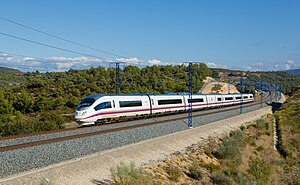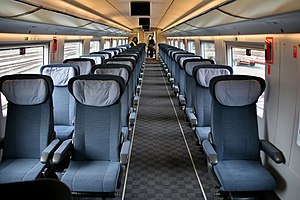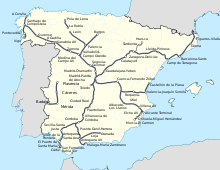
Transport in Spain is characterised by an extensive network of roads, railways, rapid transit, air routes, and ports. Its geographic location makes it an important link between Europe, Africa, and the Americas. Major forms of transit generally radiate from the capital, Madrid, located in the centre of the country, to link with the capitals of the autonomous communities.
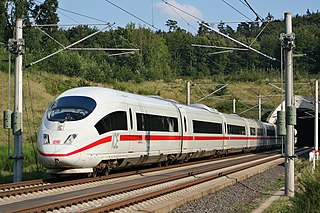
Intercity Express is a high-speed rail system in Germany. It also serves destinations in Austria, France, Belgium, Switzerland and the Netherlands as part of cross-border services. It is the flagship of the German state railway, Deutsche Bahn. ICE fares are fixed for station-to-station connections, on the grounds that the trains have a higher level of comfort. Travelling at speeds up to 320 km/h (200 mph), they are aimed at business travellers and long-distance commuters and marketed by Deutsche Bahn as an alternative to flights.

Renfe, officially Renfe-Operadora, is the national passenger railway company of Spain.
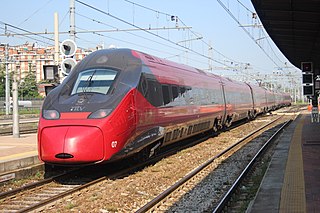
Pendolino is an Italian family of high-speed tilting trains used in Italy, Spain, Germany, Poland, Portugal, Slovenia, Finland, Russia, the Czech Republic, Slovakia, the UK, the US, Switzerland, China, and Greece. Based on the design of the Italian ETR 401, it was further developed and manufactured by Fiat Ferroviaria, which was taken over by Alstom in 2000.

Alta Velocidad Española (AVE) is a high-speed rail service operated by Renfe, the Spanish State railway company.

Siemens Velaro is a family of high-speed electric multiple unit trains built by Siemens and used in Germany, Belgium, France, the United Kingdom, the Netherlands, Spain, China, Russia, and Turkey. The Velaro is based on the ICE 3M/F high-speed trains manufactured by Siemens for Deutsche Bahn (DB). Deutsche Bahn were the first to order Siemens high-speed trains; it ordered 13 of these units in 1994, the Nederlandse Spoorwegen (NS) 4 units. The trains were delivered in 1999 for service and were labeled and marketed as the Velaro by their manufacturer, Siemens.

The Perpignan–Barcelona high-speed line is an international high-speed rail line between France and Spain. The line consists of a 175.5-kilometre (109.1 mi) railway, of which 24.6 km (15.3 mi) are in France and 150.8 km (93.7 mi) are in Spain. It crosses the French–Spanish border via the 8.3-kilometre (5.2 mi) Perthus Tunnel bored under the Perthus Pass, connecting two cities on opposite sides of the border, Perpignan in Roussillon, France, and Figueres in Catalonia, Spain. The line extends to Barcelona, and this part is sometimes referenced as an extension of the Madrid–Barcelona high-speed rail line. The Perpignan–Barcelona line is a part of the Mediterranean Corridor.
High-speed railways in Spain are in operation since 1992 when the first line was opened connecting the cities of Madrid, Córdoba and Seville. Unlike the rest of the Iberian broad gauge network, the Spanish High-speed network mainly uses standard gauge. This permits direct connections to outside Spain through the link to the French network at the Perthus Tunnel. High-speed trains run on a network of high-speed rail track owned and managed by ADIF, where the dominant service is AVE while other high speed services such as Avant, Alvia, Avlo, Euromed, Ouigo España and Iryo, as well as mid-speed (Altaria) services also operate.

ICE 3, or Intercity-Express 3, is a family of high-speed electric multiple unit trains operated by Deutsche Bahn. It includes classes 403, 406,407 and 408, which are known as ICE 3, ICE 3M, New ICE 3 and ICE 3neo respectively. Three multisystem trains, known as ICE International, are owned by Nederlandse Spoorwegen. Based on the ICE 3M/F, Siemens developed its Siemens Velaro train family with versions used in Germany, Belgium, France, the United Kingdom, the Netherlands, Spain, China, Russia and Turkey.

The Madrid–Barcelona high-speed rail line is a 621-kilometre (386 mi) standard gauge railway line inaugurated on 20 February 2008. Designed for speeds of 350 km/h (217 mph) and compatibility with neighbouring countries' rail systems, it connects the cities of Madrid and Barcelona in 2 hours 30 minutes. In Barcelona the line is connected with the Perpignan–Barcelona high-speed rail line leading into France which connects it to the European high speed network.
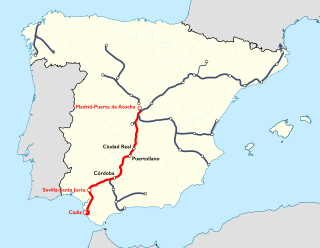
The Madrid–Sevilla high-speed line is a 472-kilometer-long (293 mi) Spanish railway line for high-speed traffic between Madrid and Seville. The first Spanish high-speed rail connection has been in use since 21 April 1992 at speeds up to 300 km/h (186 mph). Travel time between the two end points was reduced by over half.

The CRH3 Hexie is a version of the Siemens Velaro high-speed train used in China on the Beijing–Tianjin intercity railway line, Wuhan-Guangzhou Passenger Dedicated Line, Zhengzhou-Xi'an Passenger Dedicated Line and the Shanghai–Nanjing intercity railway. It is capable of service speed of 380 km/h (236 mph) as the very similar Velaro E used in Spain, but, similarly to the Sapsan, it is 300 mm (11.8 in) wider to take advantage of a more generous structure gauge and thus be able to fit in more seats in a 2+3 layout.

The Renfe Class 100 is a high-speed train used for AVE services by the Renfe Operadora, in Spain. It was the first high-speed train put into service in Spain, in 1992.

The Renfe Class 102 or S-102 is a high-speed train used for the AVE service and operated in Spain by the state-run railway company Renfe, and based on Bombardier Transportation's power car technology. Outside AVE service, Talgo markets this train as the Talgo 350.
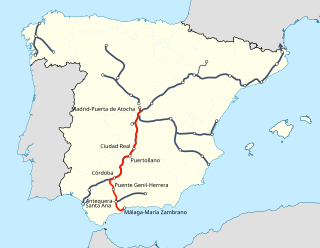
The Madrid–Málaga high-speed rail line is a standard gauge High-speed rail line of 512 km (318 mi) in length that links the city of Madrid with the city of Málaga in Spain. The line was inaugurated on 24 December 2007. At the time the service opened, Renfe Operadora was running 22 trains daily between Madrid and Málaga.

The Renfe Class 130 or S-130 is a high-speed dual-gauge, dual-voltage trainset consisting of 11 Talgo VII tilting coaches and two power cars, used on Alvia and Euromed services. The class have been nicknamed patitos (ducklings), due to the shape of the train nose.
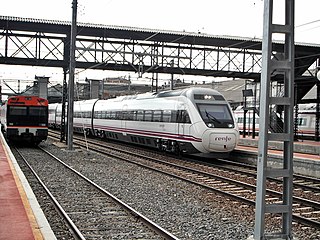
The Renfe Class 120 are electric multiple units used on Alvia high-speed rail services in Spain. Based on a family trains CAF Cepia.

Oaris is a modular high-speed train platform developed by the Spanish manufacturer CAF.
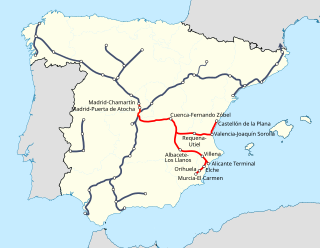
The Madrid–Levante high-speed network is a network of high-speed rail lines that connects Madrid with the Mediterranean coast of the Levante Region, specifically with Castilla-La Mancha, the Valencian Community and the Murcia Region autonomous communities.
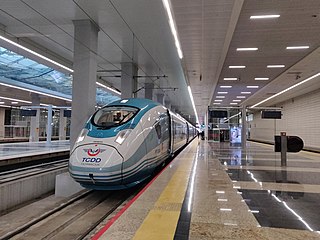
TCDD HT80000, also known as Siemens Velaro TR, is a series of high-speed electric multiple units built by Siemens for the Turkish State Railways. The EMUs are used for the Yüksek Hızlı Tren (YHT) services on the Turkish high-speed railway network and especially on the Polatlı–Konya high-speed railway, where they can reach a maximum speed of 300 km/h (186 mph).
